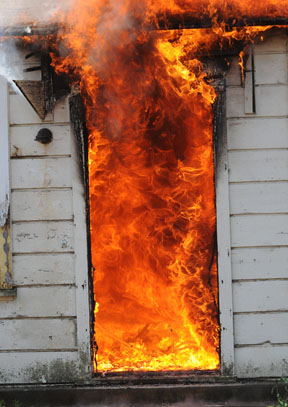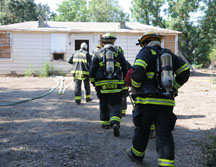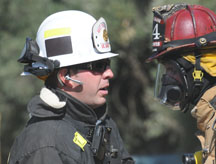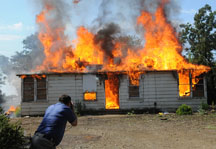News
June 30, 2009
Baxter House Gone; Site Will Be Part of Bee Friendly Garden Area
DAVIS—The Baxter House is no more. And no one is happier than Lynn Kimsey, professor and chair of the Department of Entomology and director of the Bohart Museum of Entomology.
“I’m glad to see it go,” she said.
As part of a training exercise conducted Tuesday, June 30, the UC Davis Fire Department burned the abandoned and rundown Baxter House on Bee Biology Road. The building was located east of the Harry H. Laidlaw Jr. Honey Bee Research Center, which is part of the Department of Entomology.
 |
Fire fills the Baxter House door. Click to enlarge. See more images and/or slide show on Flickr. |
Some 15 firefighters, including trainees in the UC Davis student firefighter program, participated in the training exercise, led by assistant chief Nathan Trauernicht, operations and training.
Once a private residence and then an avian lab research facility, the 1200-square-foot building was constructed in May 1938. According to Davis Wiki, the building was once the home of Maurice and Naomi Baxter; Maurice Baxter, a former university employee, retired from the university in 1968. The building later became an avian research lab operated by Michael Fry, who left the university in 2002.
The site is part of the Department of Entomology’s development plans. The half-acre Häagen-Dazs Honey Bee Haven will be located between the Laidlaw facility and the burn site. A public dedication of the bee friendly garden is planned in October.
The key goals of the garden are to provide bees with a year-around food source, to raise public awareness about the plight of honey bees and to encourage visitors to plant bee-friendly gardens of their own, Kimsey said.
“The Baxter House site will be an access to the back of the garden,” Kimsey said. “On the east side will be a quarter-acre wildflower garden financed by Haagen-Dazs.”
A five-member Sausalito-based team won the Häagen-Dazs Honey Bee Haven design competition earlier this year. Landscape architects Donald Sibbett and Ann F. Baker, interpretative planner Jessica Brainard and exhibit designer Chika Kurotaki created a series of interconnected gardens with such names as “Honeycomb Hideout,” “Nectar Nook” and “Pollinator Patch” to win the competition.
Sibbett is a principal with the Sibbett Group; Baker is a senior landscape architect with RRM Design Group; Brainard is an independent museum consultant; and Kurotaki is an exhibit designer who works for RRM Design Group.
Last December Häagen-Dazs committed $125,000 to the UC Davis Department of Entomology for the garden project. This encompasses site planning, preparation and the design competition. The design plans are online.
A public dedication of the garden is planned in October.



